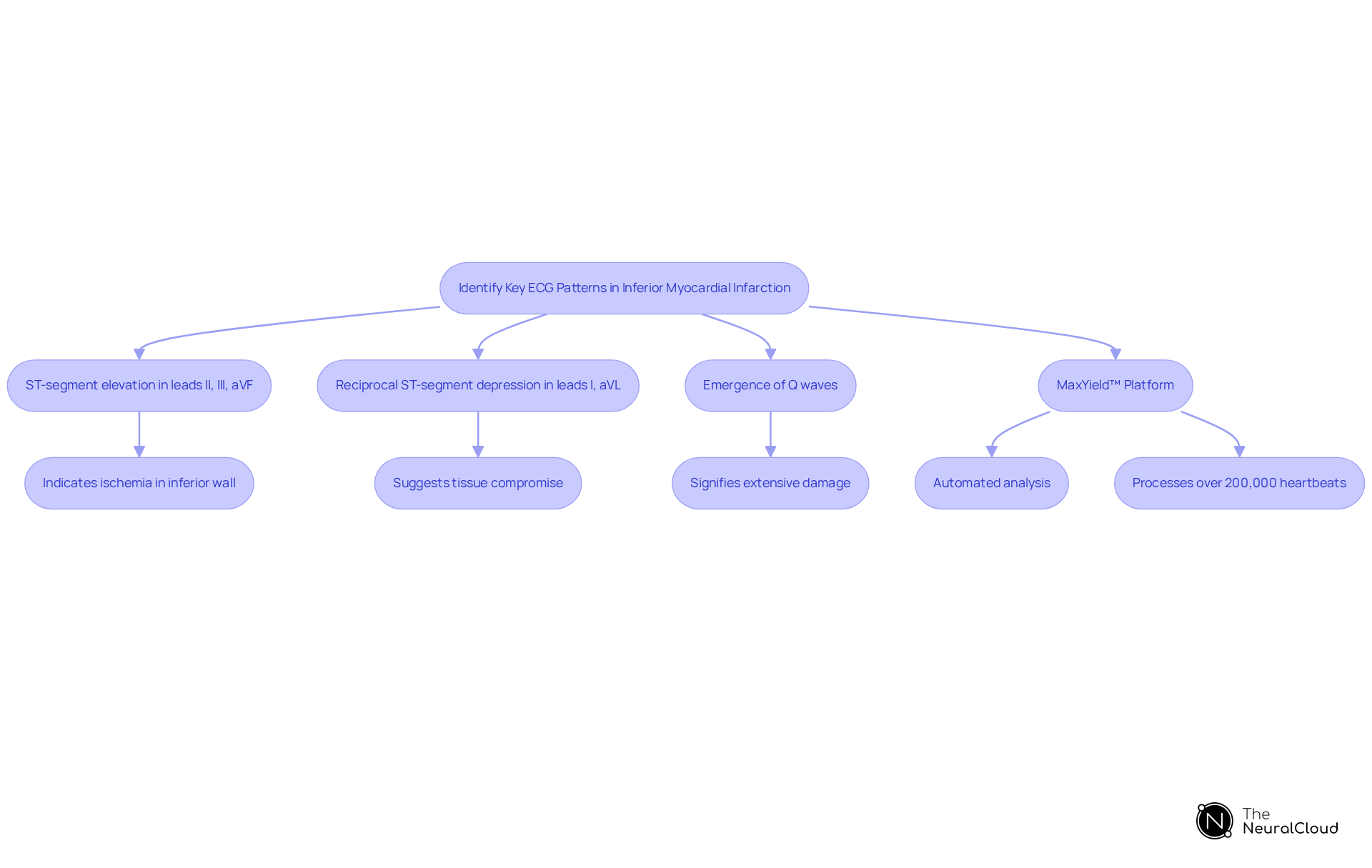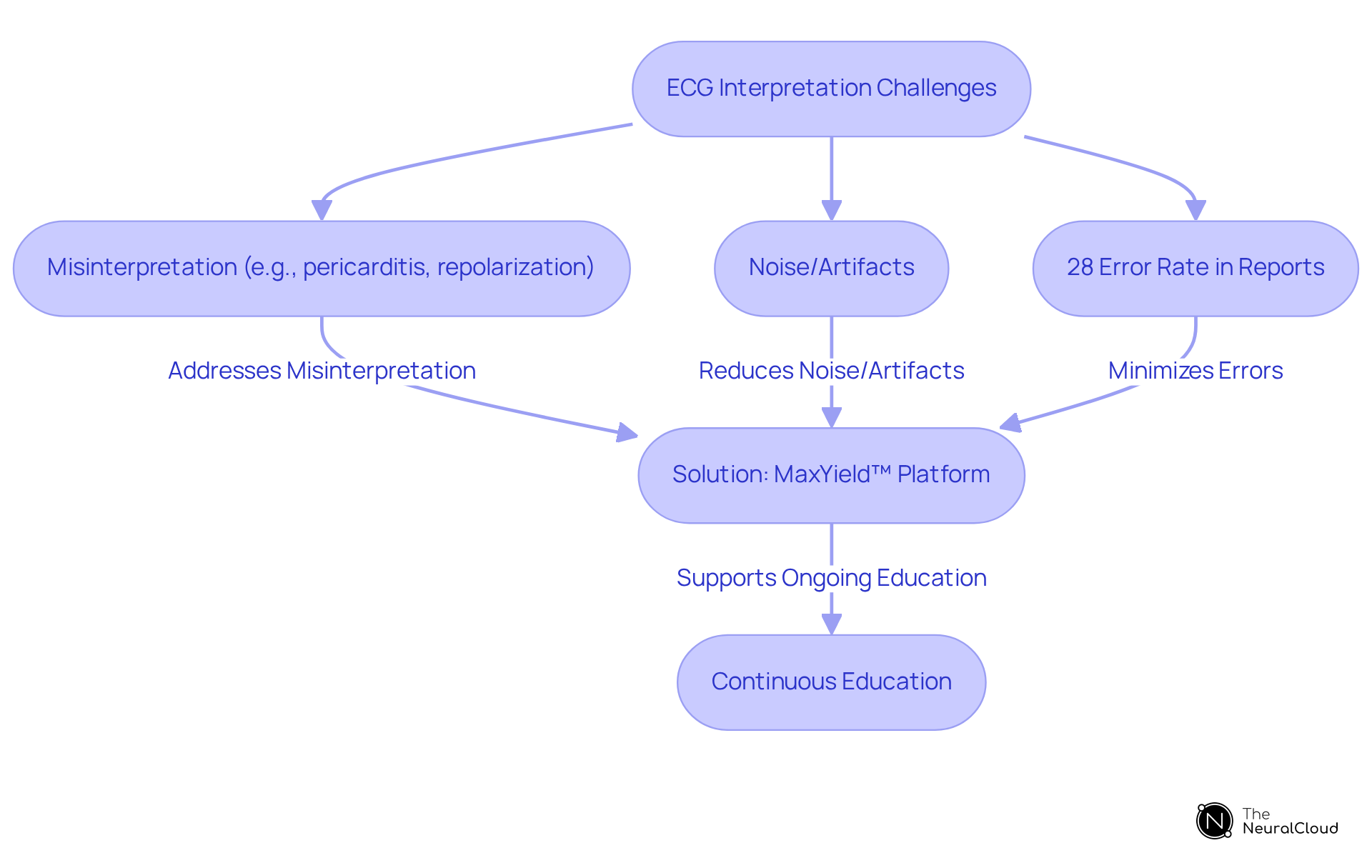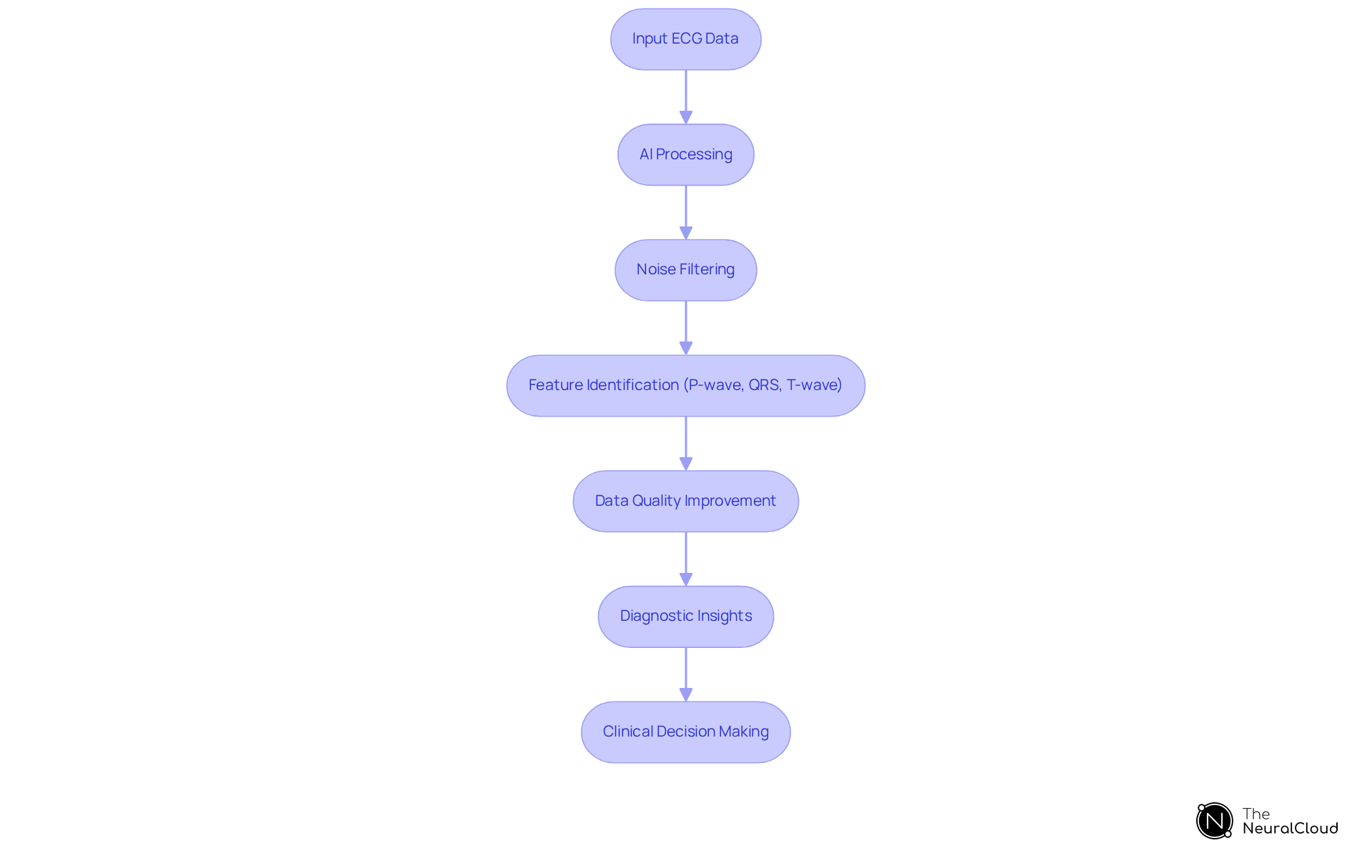Overview
Inferior myocardial infarction (IMI) is characterized by damage to the lower heart tissue due to restricted blood flow, often linked to right coronary artery obstruction. This condition poses significant clinical risks, including heart failure and arrhythmias. Recognizing key ECG patterns, such as ST-segment elevation in specific leads, is crucial for timely diagnosis. Advanced analysis technologies, like the MaxYield™ platform, play a vital role in enhancing diagnostic accuracy.
The MaxYield™ platform offers several features that streamline ECG interpretation. It automates the analysis process, significantly reducing the potential for human errors. By leveraging advanced algorithms, the platform provides healthcare professionals with precise data and insights. This capability not only improves the speed of diagnosis but also enhances the overall quality of patient care.
The advantages of utilizing the MaxYield™ platform are substantial. Healthcare professionals benefit from increased confidence in their diagnostic decisions, leading to better patient outcomes. The automation of ECG interpretation allows clinicians to focus more on patient interaction and treatment rather than on time-consuming analysis. Ultimately, the MaxYield™ platform represents a significant advancement in the field of cardiology, addressing the challenges of ECG analysis effectively.
Introduction
Understanding inferior myocardial infarction on an electrocardiogram (ECG) is essential for timely and effective patient care. This condition typically arises from restricted blood flow to the heart's lower wall, potentially leading to serious complications if not promptly recognized. By examining the key ECG patterns associated with inferior infarction, healthcare professionals can significantly enhance their diagnostic accuracy and improve patient outcomes.
However, a challenge persists: how can clinicians adeptly navigate the complexities of ECG interpretation to prevent misdiagnosis and ensure optimal treatment?
Define Inferior Myocardial Infarction and Its Clinical Relevance
Lower heart tissue damage (LHD) occurs when blood circulation to the lower wall of the heart is restricted, often due to an obstruction in the right coronary artery. This condition is clinically significant as it can lead to severe complications, including heart failure and arrhythmias. Timely recognition of inferior infarction on ECG is crucial, as it directly influences treatment decisions and can significantly improve patient outcomes.
Recent research indicates that:
- ST depression in leads V1-4, combined with elevation in two adjacent lower leads, is a strong indicator of lower occlusion myocardial infarction (OMI).
- The presence of hyperacute T-waves (HATW) can signal impending classic ST elevation changes, highlighting the necessity for vigilant ECG interpretation.
Understanding the risk factors associated with IMI, such as coronary artery disease and hypertension, is essential for healthcare providers to effectively manage and treat affected patients.
The integration of advanced ECG analysis technologies, such as those offered by Neural Cloud Solutions, enhances the clarity and reliability of ECG readings, enabling clinicians to make informed decisions swiftly.
Testimonials from leading cardiologists underscore the importance of recognizing inferior infarction on ECG patterns, which reinforces the need for continuous education and training in this critical area of cardiac care.

Identify Key ECG Patterns in Inferior Myocardial Infarction
Key ECG patterns indicating an inferior infarction on ECG prominently display ST-segment elevation in leads II, III, and aVF, which reflects ischemia in the inferior wall of the heart. These changes are often accompanied by reciprocal ST-segment depression in the anterior electrodes (I and aVL), suggesting potential compromise of heart tissue. The emergence of Q waves in these leads can further signify more extensive heart damage, highlighting the necessity for prompt clinical intervention. It is essential for clinicians to be skilled in differentiating these patterns from other conditions, such as pericarditis or right ventricular strain, to avoid misdiagnosis.
The MaxYield™ platform significantly enhances the detection of these critical ECG patterns through its automated analysis. This technology ensures that even subtle changes are accurately identified and addressed, which is vital for effective patient care. With seamless integration and compatibility with various ECG devices, MaxYield™ processes over 200,000 heartbeats in under five minutes. This capability revolutionizes ECG analysis by providing healthcare professionals with accurate and scalable solutions that enhance clarity and efficiency in clinical workflows.
By employing the MaxYield™ platform, healthcare professionals can improve their diagnostic accuracy and streamline their workflows. The platform not only aids in the timely recognition of inferior infarction on ECG but also supports better overall patient management. As a result, clinicians can focus more on patient care and less on manual analysis, ultimately leading to improved outcomes.

Discuss Diagnostic Challenges and Common Misinterpretations
Diagnostic challenges in recognizing inferior infarction on ECG frequently arise from overlapping findings with other cardiac conditions. For instance, ST-segment elevation can be misinterpreted as indicative of pericarditis or early repolarization. Additionally, noise and artifacts often obscure true ECG signals, complicating accurate interpretation. Statistics indicate that approximately 28% of ECG reports contain errors, highlighting the critical need for vigilance in ECG analysis.
To address these challenges, the MaxYield™ platform offers comprehensive analysis tools that automate the identification of key features. This platform enhances ECG analysis by significantly reducing the likelihood of diagnostic errors. By leveraging its advanced capabilities, clinicians can improve their diagnostic accuracy and efficiency.
Continuous education and training in ECG interpretation are essential for healthcare professionals to stay abreast of evolving diagnostic criteria. The MaxYield™ platform not only supports this ongoing education but also directly contributes to improved patient outcomes by facilitating more accurate diagnoses. In summary, utilizing such tools is vital for enhancing the quality of care provided to patients.

Explore Advanced ECG Analysis Technologies for Improved Diagnosis
Advanced ECG analysis technologies, such as the MaxYield™ platform from Neural Cloud Solutions, leverage artificial intelligence and machine learning to automate ECG signal interpretation. This innovation addresses the significant challenges in ECG analysis, including noise and signal artifacts, which can hinder diagnostic accuracy. By rapidly processing extensive datasets, MaxYield™ enhances diagnostic accuracy and facilitates the identification of subtle patterns that may be missed by human detection.
MaxYield™ features advanced noise filtering and adaptive algorithms, ensuring that clinicians receive precise and actionable insights crucial for timely decision-making. The platform specifically identifies and labels critical data, including P-wave, QRS complex, and T-wave features. Additionally, it salvages previously obscured sections of lengthy Holter, 1-Lead, and patch monitor recordings, significantly improving the quality of the data provided.
The advantages of using MaxYield™ extend beyond its technical capabilities. Its continuous learning algorithms allow for ongoing performance improvements, adapting to new data and evolving clinical needs. Notably, MaxYield™ can process over 200,000 heartbeats in under five minutes, enhancing workflow efficiency. This efficiency allows healthcare providers to concentrate on high-level decision-making, ultimately improving patient care.
By integrating advanced technologies like MaxYield™, healthcare providers can streamline workflows and reduce operational costs. This not only elevates the quality of patient care but also supports healthcare professionals in making informed decisions based on precise data analysis.

Conclusion
Recognizing and understanding inferior myocardial infarction on ECG is essential for effective patient management and improved clinical outcomes. This article highlights the critical importance of timely and accurate interpretation of ECG patterns that indicate inferior infarction. Such insights can directly influence treatment strategies and patient care.
Key arguments presented include the identification of specific ECG patterns, such as ST-segment elevation in leads II, III, and aVF. Additionally, advanced technologies like the MaxYield™ platform significantly enhance diagnostic accuracy. However, challenges in ECG interpretation persist, including common misinterpretations. Continuous education among healthcare professionals is necessary to mitigate these risks.
The integration of advanced ECG analysis technologies is not just a matter of efficiency; it is a crucial step toward minimizing diagnostic errors and enhancing patient outcomes. Embracing innovations like the MaxYield™ platform offers several features:
- Enhanced Diagnostic Accuracy: The platform utilizes advanced algorithms to improve interpretation of ECG patterns.
- User-Friendly Interface: Designed for ease of use, facilitating quicker decision-making for healthcare providers.
- Comprehensive Training Resources: Supports ongoing education in ECG interpretation.
By committing to ongoing education and utilizing tools like the MaxYield™ platform, healthcare providers can significantly improve their ability to detect inferior myocardial infarction, ultimately leading to better care for patients at risk.
Frequently Asked Questions
What is inferior myocardial infarction (IMI)?
Inferior myocardial infarction (IMI) occurs when blood circulation to the lower wall of the heart is restricted, often due to an obstruction in the right coronary artery, leading to lower heart tissue damage.
Why is inferior myocardial infarction clinically significant?
IMI is clinically significant because it can lead to severe complications, including heart failure and arrhythmias. Timely recognition of inferior infarction on ECG is crucial for treatment decisions and improving patient outcomes.
What are the key indicators of lower occlusion myocardial infarction (OMI) on an ECG?
Key indicators include ST depression in leads V1-4, combined with elevation in two adjacent lower leads, which strongly suggests lower occlusion myocardial infarction.
What role do hyperacute T-waves (HATW) play in ECG interpretation?
The presence of hyperacute T-waves (HATW) can signal impending classic ST elevation changes, highlighting the need for vigilant ECG interpretation.
What risk factors are associated with inferior myocardial infarction?
Risk factors for IMI include coronary artery disease and hypertension, which healthcare providers must understand to effectively manage and treat affected patients.
How can advanced ECG analysis technologies assist in the management of IMI?
Advanced ECG analysis technologies, such as those offered by Neural Cloud Solutions, enhance the clarity and reliability of ECG readings, enabling clinicians to make informed decisions swiftly.
What do testimonials from cardiologists highlight regarding the recognition of inferior infarction?
Testimonials from leading cardiologists emphasize the importance of recognizing inferior infarction on ECG patterns, reinforcing the need for continuous education and training in this critical area of cardiac care.






